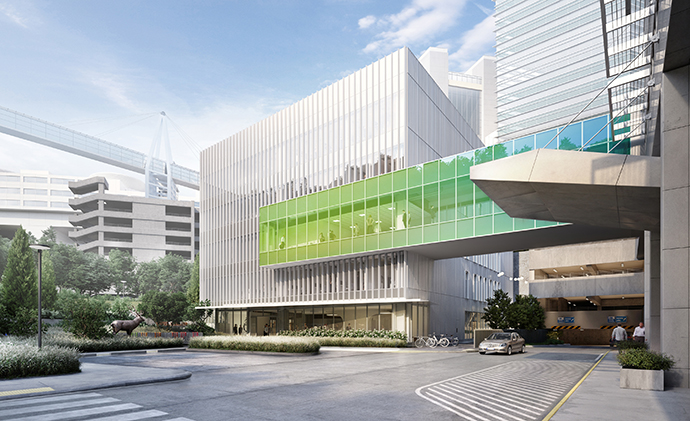
Last May, scores of onlookers cheered on as the last steel beam was hoisted atop a five-story structure under construction on OHSU’s Marquam Hill campus. Well-wishers were celebrating the “topping out” of the Oregon Elks Children’s Eye Clinic, a new, cutting-edge facility that will enable OHSU Casey Eye Institute to reach its fullest potential as a world-class academic eye center.
The nation’s first free-standing pediatric eye clinic, the building is named in recognition of a significant philanthropic investment from the Oregon State Elks Association. For seven decades, the fraternal organization has supported children’s eye care through the Elks Children’s Eye Clinic at Casey.
“Since opening our doors as an eye institute 28 years ago, Casey has been on a steady trajectory toward solving some of the most profound challenges in eye disease, from inherited disorders of the retina and macular degeneration, to serious pediatric conditions such as childhood glaucoma and retinopathy of prematurity,” said David Wilson, M.D., Paul H. Casey Chair, Department of Ophthalmology, OHSU School of Medicine and director of Casey.
“This expansion will give us the necessary space, infrastructure and technology to build on Casey’s exceptional progress in research, patient care and outreach – with the ultimate goal of ending preventable blindness both here and abroad,” he said.
Set to open next year, the new 60,000 square foot building will be home to an expanded pediatric eye clinic, retina services, the Paul H. Casey Ophthalmic Genetics Division, vision rehabilitation and a clinical trials center.
"The new clinic will enable us to provide timely care to far more children through our nationally-recognized vision screening and treatment programs," said Daniel Karr, M.D., director of the Elks Children's Eye Clinic.
The Wold Family Macular Degeneration Center, also located in the new facility, will allow Casey to serve the rising number of people with age-related macular degeneration and advance its top-tier research in diagnosis and treatment. The center is named for the late John S. Wold, a Wyoming philanthropist, business leader and former Congressman who along with his family made a substantial gift in support of the program.
The new building will free up space in Casey's existing facilities, paving the way for growth in other programs, such as cornea and glaucoma.
Collaboration is key
“The configuration of services and programs in the Oregon Elks Children’s Eye Clinic reflects a new era in ophthalmology that benefits from a team approach in eye care – even across multiple specialties,” said Andreas Lauer, M.D., Thiele-Petti Chair, Department of Ophthalmology, OHSU School of Medicine and chief of Casey’s vitreoretinal division. For example, children with genetic eye disorders can receive comprehensive care under one roof from pediatric ophthalmologists, ophthalmic geneticists and specialists in advanced imaging and vision rehabilitation.
“By bringing together experts in related areas, we’ve created a collaborative space that better serves patients and is a catalyst for bench-to-bedside discoveries,” said Lauer.
A site for the senses
The new Oregon Elks Children’s Eye Clinic already is earning rave reviews for its inspired and thoughtful design. The project, on budget and ahead of schedule, received the Portland Design Commission’s 3rd Annual Design Excellence Award this spring. And earlier this year, it was the winner of an interior design award from the Pacific Northwest chapter of the International Interior Design Association.
The building’s interior was designed with input from patients with varying levels of eyesight to ease navigation and comfort. For example, high contrast colors will be used on floors, walls and signage to help patients and visitors safely make their way throughout the building. Patients who are dilating will be able to wait in quiet, dimmable areas.
Perhaps the building’s most striking feature is the glass walkway that will connect to the existing Casey facility via the fourth floor. Constructed of a special glass, the sky bridge will dramatically shift in color depending on time of day and viewing angle. The walkway not only acts as a playful gesture bridging old and new, but its changing colors are intended to create a sense of wonder, said Wilson.
The building’s exterior will also be a “site for the senses.” Patients and visitors will enjoy a sensory garden with seating and pathways. A lighted textured wall ornamented with ribbons of colored glass will evoke the light spectrum.
Of course, the new space would not be complete without the majestic bronze Elk that has stood opposite the Casey building for decades. “We’re happy to report that the Elk will be returning to a special place of honor when the new building is completed,” said Wilson.